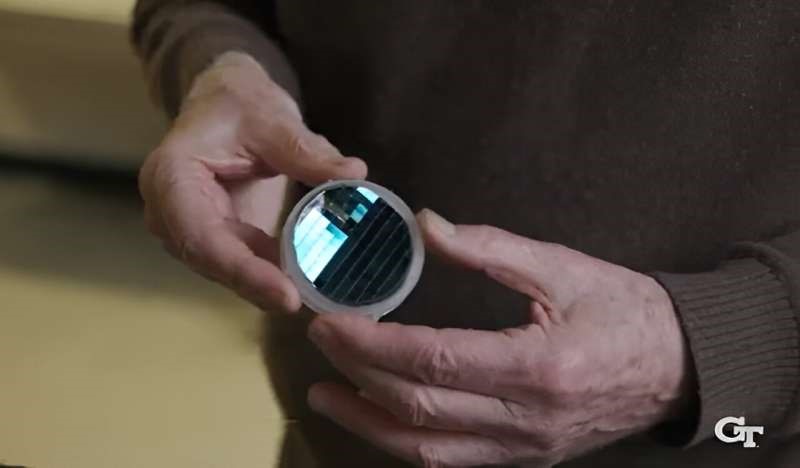Description

Disclaimer: Copyright infringement not intended.
Context
Researchers from the Georgia Institute of Technology have successfully developed world’s first functional semiconductor composed of graphene, the single atomic layer of carbon atoms renowned for its exceptional properties.
Details
Key Features of the Graphene Semiconductor
- Compatibility with Microelectronics Processing: The graphene semiconductor is engineered to align with conventional microelectronics manufacturing processes, offering compatibility for widespread adoption in electronic devices.
- Overcoming the Band Gap Challenge: Graphene's inherent lack of a band gap, a crucial property for semiconductor functionality, was a persistent hurdle. The team's breakthrough involved growing graphene on silicon carbide wafers through specialized furnaces. This process produced epitaxial graphene, chemically bonding to the silicon carbide and exhibiting semiconducting properties.
- Enhanced Performance: The graphene semiconductor showcases exceptional characteristics, boasting 10 times the electron mobility of silicon. Additionally, it offers distinctive advantages such as increased efficiency, reduced heat generation, and higher electron velocities, enabling faster electronic operations.
- Quantum Computing Implications: The material's compatibility with quantum mechanical wave properties of electrons positions it as a promising candidate for advancing quantum computing technologies, a critical requirement for realizing the potential of quantum computing.
What is Graphene?
- Graphene is a two-dimensional allotrope of carbon, arranged in a single layer of atoms bonded in a hexagonal lattice.
- It's incredibly thin, with a thickness of just one atom, yet remarkably strong and flexible. This unique structure grants it exceptional properties.
Properties of Graphene:
- Exceptional Strength: Graphene is one of the strongest materials known, about 200 times stronger than steel.
- High Electrical Conductivity: It exhibits excellent electrical conductivity, making it ideal for electronic applications.
- High Thermal Conductivity: Graphene also possesses remarkable thermal conductivity, which could enhance heat dissipation in various systems.
- Transparency: It's transparent and can absorb a wide spectrum of light, making it useful in transparent electronics and optoelectronic devices.
- Flexibility: Despite its strength, graphene is flexible, allowing its integration into flexible electronics.
Production Methods:
- Mechanical Exfoliation: The 'Scotch tape' method involves repeatedly peeling graphite layers until a single layer of graphene is obtained.
- Chemical Vapor Deposition (CVD): A popular method where carbon atoms are deposited onto a substrate to form a graphene layer.
- Liquid Phase Exfoliation: Graphene oxide is dispersed in solvents and then reduced to produce graphene.
Applications of Graphene:
- Electronics: Graphene's high electrical conductivity is promising for creating faster and more efficient transistors and other electronic components.
- Energy Storage: It's used in batteries and supercapacitors, offering increased energy storage capacity.
- Sensors: Graphene-based sensors exhibit high sensitivity for detecting gases, chemicals, and biomolecules.
- Materials: Composite materials reinforced with graphene display enhanced mechanical and thermal properties.
- Biomedical Applications: Graphene holds promise in drug delivery systems, tissue engineering, and biosensors due to its biocompatibility.

Introduction to Semiconductors
- Semiconductors are materials with electrical properties lying between conductors (like metals) and insulators (like ceramics).
- Their unique characteristic is the ability to control electrical conductivity, crucial for the functioning of various electronic devices.
Structure and Properties:
- Crystal Structure: Semiconductors possess a crystalline structure where atoms are arranged in a regular pattern. Silicon (Si) and germanium (Ge) are commonly used semiconductor materials due to their stability and controllable properties.
- Band Structure: Semiconductors exhibit energy bands—valence and conduction bands—separated by a bandgap. The bandgap determines a material's conductivity; wider bandgaps mean lower conductivity.
- Doping: To modify conductivity, semiconductors undergo doping—a process of intentionally adding impurities (dopants) like phosphorus or boron—to alter the number of charge carriers (electrons or holes) within the material.
Types and Behavior:
- Intrinsic Semiconductors: Pure semiconductors without intentional doping. Conductivity arises from thermal excitation, generating electron-hole pairs.
- Extrinsic Semiconductors: Doped semiconductors, classified as n-type (doped with elements adding free electrons) or p-type (doped with elements creating holes).
Devices and Applications:
- Diodes: Semiconductor devices allowing current flow in one direction. They're fundamental in rectifiers, voltage regulators, and light-emitting diodes (LEDs).
- Transistors: Building blocks of modern electronics. Field-effect transistors (FETs) and bipolar junction transistors (BJTs) control current flow for amplification, switching, and digital logic.
- Integrated Circuits (ICs): Silicon-based ICs comprise interconnected transistors, diodes, and resistors, enabling complex functionalities in microprocessors, memory chips, and sensors.
- Optoelectronics: Semiconductors facilitate light emission (LEDs) and detection (photodiodes and solar cells), pivotal in lighting, displays, telecommunications, and renewable energy.
Introduction to Quantum Computing
- Quantum computing harnesses the principles of quantum mechanics to manipulate information through quantum bits or qubits, enabling processing capabilities beyond classical computing.
- Unlike classical bits, which represent either 0 or 1, qubits can exist in multiple states simultaneously, known as superposition, and entangle to influence each other instantaneously.
Quantum Properties:
- Superposition: Qubits can exist in multiple states simultaneously, exponentially increasing computational capacity. This enables parallel processing and enhances computational power significantly.
- Entanglement: Qubits can become entangled, linking their states instantaneously over vast distances. This phenomenon allows for coordinated actions between qubits, pivotal for complex computations.
- Quantum Interference: Qubits exploit interference, enhancing favorable states and suppressing unwanted ones, crucial for computational efficiency and accuracy.
Quantum Gates and Algorithms:
- Quantum Gates: Similar to classical logic gates, quantum gates manipulate qubits, allowing operations like superposition, entanglement, and quantum interference.
- Quantum Algorithms: Notable algorithms like Shor's algorithm for factoring large numbers and Grover's algorithm for unstructured search problems demonstrate quantum computing's superiority over classical methods in specific tasks.
Quantum Hardware:
- Quantum Processors: Quantum computing hardware comprises quantum processors capable of handling qubits. Superconducting circuits, trapped ions, and topological qubits are among the approaches pursued by researchers.
- Quantum Error Correction: Mitigating errors arising from qubit decoherence is critical. Error correction codes and fault-tolerant techniques are under development to maintain quantum state integrity.
Applications:
- Cryptography and Security: Quantum computing threatens classical encryption algorithms but also offers quantum-resistant cryptographic solutions like quantum key distribution.
- Drug Discovery and Material Science: Quantum simulations enable accurate modeling of molecular structures, revolutionizing drug design and materials discovery.
- Optimization and Machine Learning: Quantum algorithms show promise in optimizing complex systems and enhancing machine learning processes.

Challenges:
- Decoherence: Preserving quantum states against environmental disturbances remains a significant challenge in building robust quantum computers.
- Scalability: Scaling up quantum systems while maintaining coherence and minimizing errors is crucial for practical applications.
- Hardware Development: Continual advancements in quantum hardware, control mechanisms, and error correction techniques are essential for realizing practical quantum computers.
Conclusion
The creation of a functional semiconductor derived from graphene presents a pivotal milestone in the realm of electronics. This innovation not only surmounts the limitations of traditional silicon-based technology but also heralds an era of smaller, faster, and more efficient electronic devices. With its compatibility with quantum computing and potential applications in nanoelectronics, this graphene-based semiconductor marks a significant leap towards the future of advanced computing and technology.
|
PRACTICE QUESTION
Q. Explain the recent breakthrough achieved by researchers in developing a graphene-based semiconductor and its significance in revolutionizing electronics. (250 Words)
|




![]()








